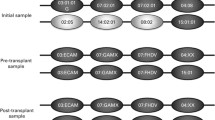Abstract
Transplantation, serological, and cytogenetic analyses on alloantigenic loss variants selected from heterozygous mouse tumors induced in F1 animals demonstrate that both 17 chromosomes have been maintained in all variants despite complete loss of oneH-2 complex. Small, subchromosomal deletion or mutation remains the most plausible explanation for alloantigenic loss variant formation in diploid or near-diploid heterozygous tumors.
Similar content being viewed by others
References
Bayreuther, K., and Klein, E.: Cytogenetic, serologic, and transplantation studies on a heterozygous tumor and its derived variant sublines.J. Natl. Cancer Inst. 21:885–923, 1958
Bjaring, B., and Klein, G.: Antigenic characterization of heterozygous mouse lymphomas after immunoselection in vivo.J. Natl. Cancer Inst. 41:1411–1429, 1968
Dalianis, G., Wiener, F., and Klein, G.: Alloantigenic variant selection in vitro from a mouse lymphoma-sarcoma hybrid.Immunogenetics 1: 370–381, 1974
Hellström, K. E.: Chromosomal studies on primary methylcholanthrene-induced sarcomas in the mouse.J. Natl. Cancer Inst. 23:1019–1033, 1959
Hellström, K.E.: Studies on isoantigenic variation in mouse lymphomas.J. Natl. Cancer Inst. 25:237–269, 1960
Klein, E., Klein, G., and Révész, L.: Permanent modification (mutation?) of a histocompatibility gene in a heterozygous tumor.J. Natl. Cancer Inst. 19:95–114, 1957
Klein, E., and Klein, G.: The use of histocompatibility genes as markers for the study of isoantigenic variation in populations of tumor cells.In F. Albert and P. Medawar (eds.)Biological Problems of Grafting; pp. 241–270, Blackwell, Oxford, 1959
Klein, E., Klein, G., and Hellström, K.E.: Further studies on isoantigenic variation in mouse carcinomas and sarcomas.J. Natl. Cancer Inst. 25:271–294, 1960
Klein, E.: Studies on the mechanism of isoantigenic variant formation in heterozygous mouse tumors. I. Behavior of H-2 antigens D and K: Quantitative absorption tests on mouse sarcomas.J. Natl. Cancer Inst. 32:559–576, 1964
Klein, E., and Klein, G.: Studies on the mechanism of isoantigenic variant formation in heterozygous mouse tumors. III. Behavior of H-2 antigens D and K when located in the transposition.J. Natl. Cancer Inst. 32:569–578, 1964
Klein, G., and Klein, E.: Detection of an allelic difference at single gene locus in a small fraction of a large tumour cell population.Nature (Lond.)178:1389–1391, 1956
Klein, G., and Klein, E.: Cytogenetics of experimental tumors.In R. W. Cumley (ed.):Genetics and Cancer; pp. 241–270, University of Texas Press, Austin, 1959
Klein, G., and Klein, E.: Histocompatibility changes in tumors.J. Cell Comp. Physiol. 52 (Suppl. 1): 125–163, 1958
Klein, G., Gars, U., and Harris, H.: Isoantigen expression in hybrid mouse cell.Exp. Cell Res. 62:149–160, 1970
Klein, G., Friberg, S. Jr., and Harris, H.: Two kinds of antigenic suppression in tumor cells revealed by cell fusion. J. Exp. Med.135:839–849, 1972
Lyon, M. F., Butler, J. M., and Kemp, R.: The position of the centromers in linkage group II and IX of the mouse.Genet. Res. 11:183–201, 1968
Ozer, L., Klein, G., and Ozer, J. H.: Studies on the mechanism of isoantigenic variant formation in heterozygous mouse tumors. IV.H-2 component analysis of an (A/Sn × A.SW)F1 lymphoma.J. Natl. Cancer Inst. 36:233–247, 1966
Pious, D., Hawley, P., and Forrest, G.: Isolation and characterization of HL-A variants in cultered human lymphoid cells. Proc. Natl. Acad. Sci. USA70:1397–1400, 1973
Reif, A. E.: An experimental test of two general relationships to describe the adsorption of antibodies by cells and tissues.Immunochemistry 3:267–278, 1966
Wang, H.C., and Fedoroff, S.: Banding of human chromosomes treated with trypsin.Nature New Biol. 235:52–54, 1972
Wiener, F., Dalianis, G., Klein, G., and Harris, H.: Cytogenetic studies on the mechanism of isoantigenic variants in somatic cell hybrids. I. Banding analyses of isoantigenic variant sublines derived from the fusion of TA 3 Ha carcinoma with MSWBS sarcoma cells.J. Natl. Cancer Inst. 52:1779–1796, 1974
Author information
Authors and Affiliations
Rights and permissions
About this article
Cite this article
Wiener, F., Dalianis, T. & Klein, G. Cytogenetic studies onH-2 alloantigenic loss variants selected from heterozygous tumors. Immunogenetics 2, 63–72 (1975). https://doi.org/10.1007/BF01572275
Received:
Issue Date:
DOI: https://doi.org/10.1007/BF01572275




